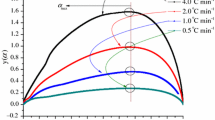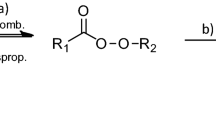Abstract
Exothermic decomposition of di-tert-butyl peroxide (DTBP) was measured and assessed for determination of onset or threshold point which is essential for hazard evaluation or early detection of runaway reaction. Thermal decomposition of DTBP was conducted by differential scanning calorimeter and thermal scanning unit. Criteria of onset points are determined by and compared by the deflection curve of exothermic behavior (or heat flow), selected pressure, self-heat rate, or pressure-rising rate, respectively. Exothermic onset temperature of DTBP can be determined as low as 73.5 °C by pressure selected at 1.5 bar. Onset point determined by selected pressure is more sensitive and superior to the onset temperature traditionally measured by thermal analysis, adiabatic calorimetry using heat-wait-search methodology or theoretical approaches.



Similar content being viewed by others
Abbreviations
- a :
-
Constant
- b :
-
Constant
- C :
-
Constant
- C p :
-
Liquid specific heat at constant volume (kJ kg−1 °C−1)
- ΔH rea :
-
Heat of reaction under reacting stage (kJ mol−1)
- ΔH :
-
Overall heat of reaction (kJ mol−1)
- k :
-
Rate constant (M1−n sec−1)
- M g :
-
Molecular mass of gas (kg mol−1)
- m g :
-
Mass of gas (kg)
- n :
-
Order of reaction
- Δn c :
-
Increase of moles of gases after and before decomposition by considering the corrected volume (mol)
- dP/dt :
-
Pressure derivative with respect to time (bar min−1)
- P g :
-
Gas pressure (bar)
- P set :
-
Set pressure (bar)
- P tot :
-
Total pressure (bar)
- P V :
-
Vapor pressure (bar)
- P max :
-
Maximum pressure measured in test bomb (bar)
- ΔP :
-
Increase of pressure after and before decomposition (bar)
- ΔP tot :
-
Pressure difference between final and initial state of reactant (bar)
- \( \dot{Q} \) :
-
Heat flux (W g−1)
- R :
-
Gas constant (8.314 J mol−1 K−1)
- T :
-
Absolute temperature of system (K or °C)
- T o :
-
Temperature of onset point (K or °C) (Traditional definition in thermal analysis, the temperature found by extrapolating the baseline and the leading side of the peak to their intersection)
- T a :
-
Temperature of onset point (K or °C) (The temperature at which a deflection from the established baseline is first observed, with a signal-to-noise ratio at about 5 or heat flow larger than the sensitivity of the calorimeter)
- T Mf :
-
Final measured temperature (K or °C)
- T M0 :
-
Initial measured temperature (K or °C)
- dT/dt :
-
Self-heat rate with respect to temperature or time (°C min−1)
- (dT/dt)onset :
-
Self-heat rate at onset point (°C min−1)
- V :
-
Volume of peroxide (m3)
- V o :
-
Volume of test bomb (m3)
- α:
-
Conversion
- dα/dt :
-
Rate of conversion
- Φ :
-
Thermal inertia
- g:
-
Gas phase
- max:
-
Maximum
- v:
-
Vapor phase
References
Ho TC, Duh YS, Chen JR. Case studies of incidents in runaway reactions and emergency relief. Proc Saf Prog. 1998;17:259–62.
Duh YS, Wu XH, Kao CS. Hazard ratings for organic peroxides. Proc Saf Prog. 2008;27:89–99.
ASTM E537-86, Standard Test Method for Assessing the Stability of Chemicals by Methods of Differential Thermal Analysis.
ASTM E476-87(Reapproved 1993), Standard Test Method for Thermal Instability of Confined Condensed Phase System (Confinement Test).
ASTM E1981-98 (Reapproved 2004), Standard Guide for Assessing Thermal Stability of Materials by Methods of Accelerating Rate Calorimetry.
TA4000 operation instructions, Mettler Company, Switzerland; 1993.
Hazard Evaluation Laboratory Ltd.; 2005.
NFPA 704, Standard system for the identification of the hazards of materials for emergency response, National Fire Protection Association, 2012.
Hsu JM, Su MS, Huang CY, Duh YS. Calorimetic studies and lessons on fires and explosions of a chemical plant producing CHP and DCPO. J Hazard Mater. 2012;217–218:19–29.
Blaine R. The search for kinetic reference materials for adiabatic and differential scanning calorimetry. J Ther Anal Calorim. 2011;106:25–31.
Talouba IB, Balland L, Mouhab N, Abdelghani-Idrissi MA. Kinetic parameter estimation for decomposition of organic peroxides by means of DSC measurements. J Loss Prev Proc Ind 2011;24:391–6.
Lizuka Y, Surianarayanan M. Comprehensive kinetic model for adiabatic decomposition of di-tert-butyl peroxide. Ind Eng Chem Res. 2003;42:2987–95.
Kersten RJA, Boers MN, Stork MM, Visser C. Results of a Round-Robin with di-tert-butyl peroxide in various adiabatic equipment for assessment of runaway reaction hazards. J Loss Prev Proc Ind 2005;18:145–51.
Lu Y, Ng D, Mannan MS. Prediction of reactivity hazards for organic peroxides using the QSPR approach. Ind Eng Chem Res. 2011;50:1515–22.
Author information
Authors and Affiliations
Corresponding author
Appendix Chemical equations for the decomposition of DTBP
Appendix Chemical equations for the decomposition of DTBP
DTBP (stoichiometric decomposition)
DTBP (by GC/Mass) [12] (non- stoichiometric decomposition)
Rights and permissions
About this article
Cite this article
Duh, YS., Wang, WF. & Kao, CS. Novel validation on pressure as a determination of onset point for exothermic decomposition of DTBP. J Therm Anal Calorim 116, 1233–1239 (2014). https://doi.org/10.1007/s10973-014-3690-x
Received:
Accepted:
Published:
Issue Date:
DOI: https://doi.org/10.1007/s10973-014-3690-x




